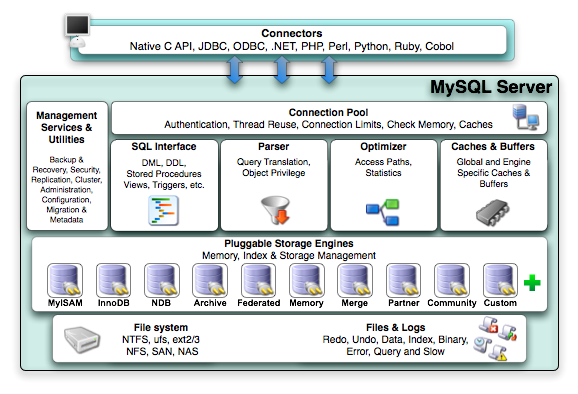- 13 Storage Engines
- 13.1 Overview of MySQL Storage Engine Architecture
- 13.2 Supported Storage Engines
- 13.3 Setting the Storage Engine
- 13.4 The MyISAM Storage Engine
- 13.5 The Maria Storage Engine
- 13.6 The InnoDB Storage Engine
- 13.7 The MERGE Storage Engine
- 13.8 The MEMORY (HEAP) Storage Engine
- 13.9 The EXAMPLE Storage Engine
- 13.10 The FEDERATED Storage Engine
- 13.11 The ARCHIVE Storage Engine
- 13.12 The CSV Storage Engine
- 13.13 The BLACKHOLE Storage Engine
The MySQL pluggable storage engine architecture allows a database professional to select a specialized storage engine for a particular application need while being completely shielded from the need to manage any specific application coding requirements. The MySQL server architecture isolates the application programmer and DBA from all of the low-level implementation details at the storage level, providing a consistent and easy application model and API. Thus, although there are different capabilities across different storage engines, the application is shielded from these differences.
The MySQL pluggable storage engine architecture is shown in Figure 13.1, “The MySQL architecture using pluggable storage engines”.
The pluggable storage engine architecture provides a standard set of management and support services that are common among all underlying storage engines. The storage engines themselves are the components of the database server that actually perform actions on the underlying data that is maintained at the physical server level.
This efficient and modular architecture provides huge benefits for those wishing to specifically target a particular application need — such as data warehousing, transaction processing, or high availability situations — while enjoying the advantage of utilizing a set of interfaces and services that are independent of any one storage engine.
The application programmer and DBA interact with the MySQL database through Connector APIs and service layers that are above the storage engines. If application changes bring about requirements that demand the underlying storage engine change, or that one or more additional storage engines be added to support new needs, no significant coding or process changes are required to make things work. The MySQL server architecture shields the application from the underlying complexity of the storage engine by presenting a consistent and easy-to-use API that applies across storage engines.


User Comments
Add your own comment.